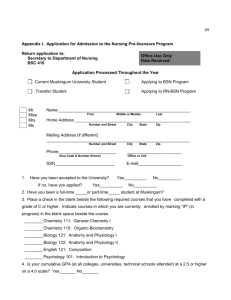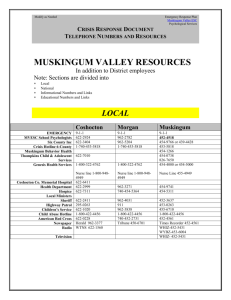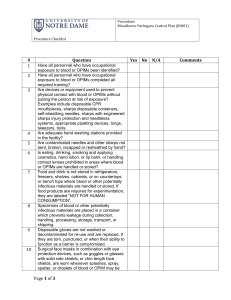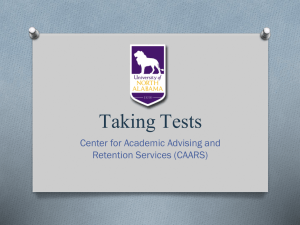Bloodborne Pathogen Exposure Plan
advertisement
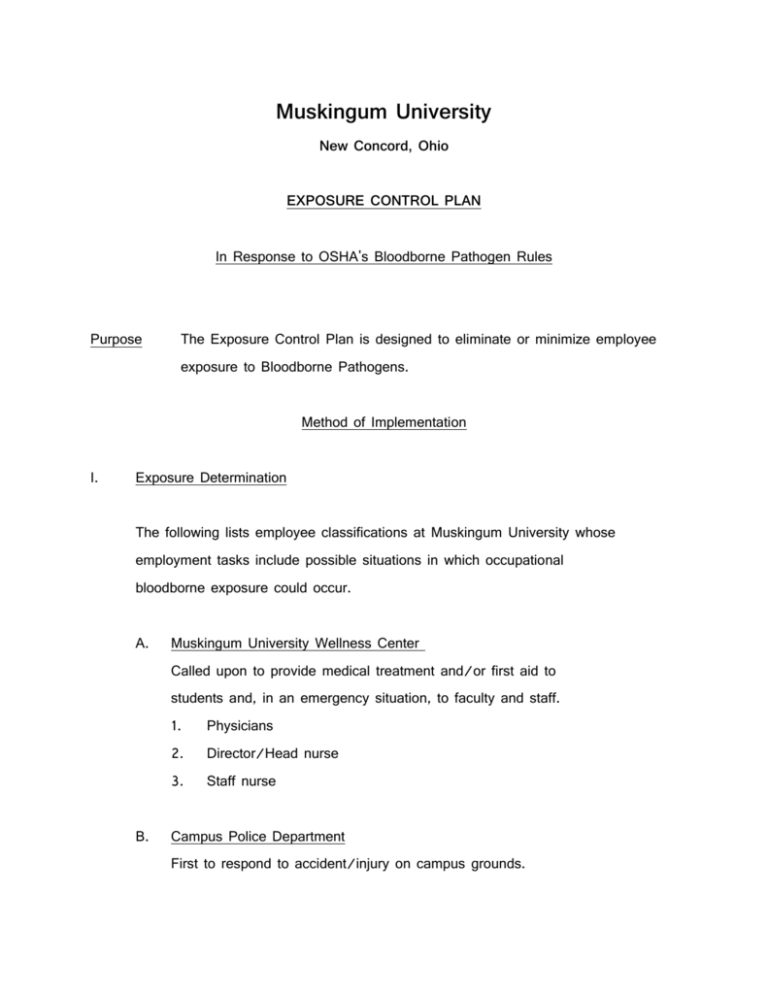
Muskingum University New Concord, Ohio EXPOSURE CONTROL PLAN In Response to OSHA's Bloodborne Pathogen Rules Purpose The Exposure Control Plan is designed to eliminate or minimize employee exposure to Bloodborne Pathogens. Method of Implementation I. Exposure Determination The following lists employee classifications at Muskingum University whose employment tasks include possible situations in which occupational bloodborne exposure could occur. A. Muskingum University Wellness Center Called upon to provide medical treatment and/or first aid to students and, in an emergency situation, to faculty and staff. B. 1. Physicians 2. Director/Head nurse 3. Staff nurse Campus Police Department First to respond to accident/injury on campus grounds. C. 1. Director 2. Campus Police Officers Athletic Trainer and Assistant Athletic Trainer Responds to injuries during play at campus sporting events and/or practices. D. Custodian(s) of Muskingum University Wellness Center Possible risk of exposure during housekeeping duties. E. Muskingum University Center for Child Development Possible risk of exposure upon injury or illness of a child. 1. Director 2. Staff OSHA has not considered these categories of employees to be at risk for occupational exposure to blood. The University, however, has included them in this training. F. Residence Life Staff Possible risk of exposure upon incidents in Residence Hall 1. Area Coordinators - required 2. Associate Dean of Student Life 3. Counselor 4. 5. Assistant Dean Assistant Dean Student Services OSHA has not considered these categories of employees to be at risk for occupational exposure to blood. The University has included them in this training to inform them of a possible occupational risk to Hepatitis A, a less serious illness (carried in human waste). G. Physical Plant 1. Maintenance and Custodial Staff Grounds Staff II. Methods of Compliance General Standard Precautions (See section on Standard Precautions) shall be observed by staff listed in Section I to prevent contact with blood or other potentially infectious materials. Under circumstances in which differentiation between body fluid type is difficult or impossible, all body fluids shall be considered potentially infectious materials. A. B. C. III. All employees who fall under Section I Exposure Determination are instructed on Standard Precautions, which is a prerequisite to starting work, and annually thereafter. All employees listed in Section I are expected to observe and follow Standard Precautions at the start of their employment at Muskingum University and every work-day thereafter. Employees listed in Section I not complying to Standard Precautions will be handled according to established disciplinary procedures up to and including termination. General Engineering and Work Practice Controls shall be used to eliminate or minimize employee exposure. These controls shall be examined and maintained or replaced on a regular schedule by each affected department head. General Engineering controls consist of, but are not limited to: A. Sharps Containers located in Muskingum University Wellness Center and/or athletic facilities. 1. 2. 3. 4. B. injection. Puncture resistant sharps containers labeled with a biohazard symbol are for the disposal of any contaminated sharps. Each area using sharps containers has extras and replace the containers as they become full. Sharps containers from Athletic Department can be hand-carried to the Muskingum University Wellness Center for disposal if sealed in punctureresistant container. Contaminated sharps are not to be bent, cut, or recapped. Safety Needles 1. The Wellness Center uses safety needles when medication is administered by C. Biohazard Safety Shield 1. Lab specimens are placed within plastic biohazard containers provided by Genesis Healthcare System. The specimen is transferred to the Adair Campus lab via that facility's courier. For all employees listed in Section I, Work Practice Controls consist of, but are not limited to: A. Hand washing. B. No recapping, bending, or cutting of contaminated sharps. C. No eating, drinking, applying cosmetics or lip balm or handling contact lenses in work areas where there is a reasonable likelihood of occupational exposure. D. Food and drink are not stored where blood or other potentially infectious materials are present. E. All procedures involving blood or other potentially infectious materials will be performed in such a manner as to minimize splashing, splattering, or generation of droplets. F. Mouth pipetting is prohibited. G. Specimen containers designed not to leak are used for specimens of blood or other potentially infectious materials. Bagging of the container is required in the event the specimen container does leak or the outside becomes contaminated. H. Contaminated equipment is autoclaved at the Muskingum University Wellness Center according to guidelines provided by the American Sterilizer Manufacturer of Erie, PA. Equipment may be hand-carried to the Muskingum University Wellness Center from the Athletic Department if in impervious, labeled biohazard container. If contaminated, reusable sharps are to be processed in a punctureresistant biohazard container. Personal Protective Equipment In work environments where there is opportunity for occupational exposure, Muskingum University shall provide, as appropriate, at no cost to the employee, appropriate personal protective equipment such as, but not limited to, gloves, protective boots, gowns, laboratory coats, face shields or masks and goggles for eye protection, mouthpieces, resuscitation bags, pocket masks, or other ventilation devices as appropriate for job responsibilities. Personal protective equipment will be considered "appropriate" only if it does not permit blood or other potentially infectious materials to pass through to or reach the employee's work clothes, street clothes, undergarments, skin, eyes, mouth, or other mucous membranes under normal conditions of use and for the duration of time which the protective equipment will be used. A. B. IV. Personal protective equipment is accessible to areas at risk for exposure and is to be utilized when an exposure is anticipated. Self-contained kits will be available in the Campus Police office, Muskingum University Wellness Center, Center for Child Development, athletic training facility and Student Life office and will include resuscitation guards. Housekeeping/Custodial The staff shall ensure that the work site is maintained in a clean and sanitary condition. The Director of the Muskingum University Wellness Center and the Supervisor of Custodial Services shall determine and implement an appropriate written schedule for cleaning and method of decontamination based upon the location within the facility, type of surface to be cleaned, type of soil present, and the tasks or procedures being performed in the area. All equipment and environmental and working surfaces shall be cleaned and decontaminated after contact with blood or other potentially infectious materials. V. A. Routine Cleaning by Custodial Staff 1. Routinely restroom surfaces should be sprayed with a cleanser containing germicidal product during clean-up. 2. Bodily fluids (vomit, blood) should be sprayed with a germicide spray before applying a soaking product for clean-ups and disposal. 3. Soiled materials used to clean up blood, vomit, or bodily functions are to be placed in red water-tight bio-hazard bags and delivered routinely to the Wellness Center for disposal. 4. Protective equipment, Standard Precautions, and workplace controls must be practiced. 5. Wash hands. B. Routine Cleaning of Wellness Center by Custodial Staff 1. Sweep Center or treatment area daily and mop with 5.25% Sodium Hypochlorite (Clorox and water 1:10) or compatible solution. 2. All counter tops, sinks, and treatment equipment shall be washed with the same solution as in IV. A.1. (Treatment and pharmacy lab-daily. Whole office- weekly). 3. Empty trash. 4. Same as IV. A. 1-4. C. Post-Treatment Cleaning of Wellness Center or Athletic Training Area by Medical or Professional Staff 1. Place all used bandages, compressors, or gauze in infectious waste container. 2. Sharps containers are to be utilized to deposit used needles, syringes, splinters, glass fragments or any other contaminated sharp. 3. Bloody, contaminated clothing or laundry items should be placed in a moisture tight container (red, biohazard bag) for future cleaning or discarding. 4. Gloves are not to be removed until all post-treatment cleaning is completed. 5. Wash hands well. Regulated Waste (Sharps and Other) A. Sharps containers and all infectious waste will be placed in the red impervious biohazard container provided by Steri-cycle. B. Steri-cycle will collect the bio-hazard container on need-based pick-up. No infectious waste or containers are to are to be placed in the general waste or trash containers. C. The Muskingum University Wellness Center is the central location for sharps containers and red bio-hazard bags. VI. Contaminated Laundry Appropriate staff; including Athletic Trainer and Assistant Athletic Trainer, are instructed on the procedure for appropriately handling contaminated laundry. This instruction is done in general orientation and annually thereafter. A. B. C. VII. Hepatitis B Vaccine Muskingum University shall make available the Hepatitis B vaccine and vaccination series to all employees who have the potential for occupational exposure to bloodborne pathogens. This will be made available after the employee has received the required training and within ten days of initial assignment. A. B. C. VIII. Gloves, and/or other personal protective equipment, are to be worn. Contaminated laundry shall be placed into moisture-tight containers (red biohazard bags) for immediate or future cleaning. Contaminated laundry shall be washed on site in hot, soapy water to which Chlorox bleach has been added. Hepatitis B vaccine is offered free to the appropriate staff after attending Hepatitis B training. Those employees who decline to accept Hepatitis B vaccine are required to sign a waiver so stating. Hepatitis B vaccine is available on an ongoing basis for the employee in the event that they initially decline the vaccine and later decide to accept. Hepatitis B is administered by the Muskingum University Wellness Center nurses who act under the direction of policies approved by a licensed physician under contract with Muskingum University. Post Exposure Evaluation and Follow-Up All medical evaluations and procedures, post exposure lab testing, including prophylaxis are: A. B. C. Made available at no cost to the employee. Made available through the Muskingum University Wellness Center or Genesis Occupational Health Services. Provided in accordance with current recommendations of CDC or ACIP. Policies are reviewed annually and updated as new recommendations are published. D. Following an exposure incident, it is the employee's responsibility to report and be evaluated by a University nurse or practicing local physician and a history taken as to: 1. Route of exposure. 2. Circumstances under which the incident occurred. 3. Identification and documentation of source, if known. E. Any lab testing is done by a CAP accredited laboratory. Exposed individual will be referred to Genesis Occupational Health for treatment and follow-up and prophylaxis. IX. X. Health Care Professional's Written Opinion A copy of the evaluating health care professional's written opinion will be provided to the employee within 15 days of the completion of the evaluation. A. Written opinion for Hepatitis B consists of: 1. Determine whether Hepatitis B vaccine is indicated for the employee. 2. Indicate if the employee has received such vaccination already. B. Written opinion for Post Exposure Evaluation and follow-up consists of: 1. The employee being informed of the results of the evaluation. 2. The employee being told about any medical conditions resulting from exposure to blood or other potentially infectious materials which require further evaluation or treatment. Communication of Hazards to Employees Warning labels shall be affixed to containers of regulated waste, refrigerators, and freezers containing blood or other potentially infectious material and other containers used to store, transport, or ship blood or other potentially infectious materials, except when: A. B. Red bags or red containers are used. Individual containers of blood or other potentially infectious materials that are placed in a labeled container during transport, shipment, or disposal are used. Employees are given information regarding infection hazards on the day of orientation and annually thereafter. This includes: A. B. C. XI. Display of the biohazard symbol and an explanation as to what items this label should be affixed. An explanation of our red bag system for infectious waste and linen. An explanation of how to properly handle any specimens. Information and Training The training program shall contain at a minimum the following elements: A. B. C. D. E. F. G. An accessible copy of the regulatory text of this standard and an explanation of its contents. A general explanation of the epidemiology and symptoms of bloodborne diseases. An explanation of the modes of transmission of bloodborne pathogens. An explanation of Muskingum University's Exposure Control Plan. An explanation of the appropriate methods for recognizing tasks and other activities that may involve exposure to blood and other potentially infectious materials. An explanation of the use and limitations of methods that will prevent or reduce exposure including appropriate engineering controls, work practices, and personal protective equipment. Information on the types, proper use, location, removal, handling, decontamination, and disposal of personal protective equipment. H. I. J. K. L. M. N. XII. An explanation of the basis for selection of personal protective equipment. Information on the Hepatitis B vaccine, including information on its efficacy, safety, method of administration and the benefits of being vaccinated. It will be noted that the vaccination will be offered free of charge. Information on the appropriate actions to take and persons to contact in an emergency involving blood or other potentially infectious materials. An explanation of the procedure to follow if an exposure incident occurs, including the method of reporting the incident and the medical follow-up that will be made. Information on the post-exposure evaluation and follow-up that Muskingum University is required to provide for the employee following an exposure incident. An explanation of the biohazard signs/labels and/or color coding used by Muskingum University. An opportunity for interactive questions and answers with the person conducting the training session. Record Keeping Muskingum University shall establish and maintain a confidential medical file including education and training records for each employee with occupational exposure separate from personnel files. A. B. C. The Human Resources Office shall keep an on-going current medical/exposure record of the employee (medical record to be kept for the duration of employment plus 30 years) including dates of waiver or vaccine. This record is initiated at the time of employment and is kept in the Human Resources Office. Training records are initiated at the time of the employee's first education/training program and are kept for three years from the time training occurred. (See Form)
